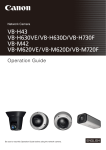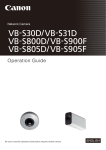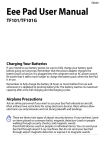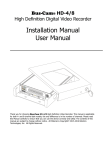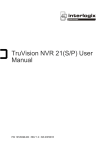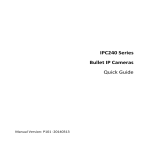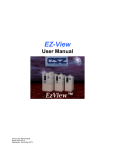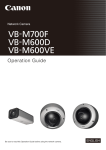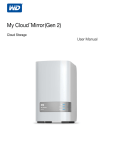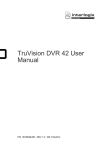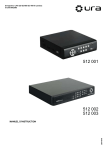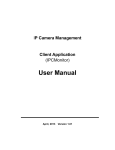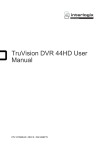Download Network Video Recorders
Transcript
Network Video Recorders User Manual Manual Version: V1.01 Thank you for purchasing our product. If there are any questions, or requests, please do not hesitate to contact the dealer. Copyright Copyright 2015 Zhejiang Uniview Technologies Co., Ltd. All rights reserved. No part of this manual may be copied, reproduced, translated, or distributed in any form or by any means without prior consent in writing from our company. Trademark Acknowledgement and other Uniview's trademarks and logos are the property of Zhejiang Uniview Technologies Co., Ltd. Other trademarks, company names and product names contained in this manual are the property of their respective owners. Disclaimer CAUTION! The default password is used for your first login. To ensure account security, please change the password after your first login. You are recommended to set a strong password (no less than eight characters). To the maximum extent permitted by applicable law, the product described, with its hardware, software, firmware and documents, is provided on an “as is” basis. Best effort has been made to verify the integrity and correctness of the contents in this manual, but no statement, information, or recommendation in this manual shall constitute formal guarantee of any kind, expressed or implied. We shall not be held responsible for any technical or typographical errors in this manual. The contents of this manual are subject to change without prior notice. Update will be added to the new version of this manual. Use of this manual and the product and the subsequent result shall be entirely on the user’s own responsibility. In no event shall we be reliable to you for any special, consequential, incidental, or indirect damages, including, among others, damages for loss of business profits, business interruption, or loss of data or documentation, or product malfunction or information leakage caused by cyber attack, hacking or virus in connection with the use of this product. Video and audio surveillance can be regulated by laws that vary from country to country. Check the law in your local region before using this product for surveillance purposes. We shall not be held responsible for any consequences resulting from illegal operations of the device. The illustrations in this manual are for reference only and may vary depending on the version or model. The screenshots in this manual may have been customized to meet specific requirements and user preferences. As a result, some of the examples and functions featured may differ from those displayed on your monitor. This manual is a guide for multiple product models and so it is not intended for any specific product. Due to uncertainties such as physical environment, discrepancy may exist between the actual values and reference values provided in this manual. The ultimate right to interpretation resides in our company. Environmental Protection This product has been designed to comply with the requirements on environmental protection. For the proper storage, use and disposal of this product, national laws and regulations must be observed. Symbols The symbols in the following table may be found in this manual. Carefully follow the instructions indicated by the symbols to avoid hazardous situations and use the product properly. Symbol Description WARNING! Indicates a hazardous situation which, if not avoided, could result in bodily injury or death. CAUTION! Indicates a situation which, if not avoided, could result in damage, data loss or malfunction to product. NOTE! Means useful or supplemental information about the use of product. Contents Preface ················································································································································1 Part I Local Operations ························································································································1 1 Before You Begin ······························································································································1 Login ···························································································································································1 Local Operations ········································································································································2 2 Initial Configuration ·························································································································5 Preparation ················································································································································5 Startup Wizard ···········································································································································6 3 Preview ·············································································································································9 Status Icons in the Preview Window ·········································································································9 Preview Window Toolbar·························································································································10 Shortcut Menu in Preview Window ·········································································································11 Example of Sequence Operation ·············································································································12 Zoom ························································································································································13 Image Configuration ································································································································14 Preview Configuration ·····························································································································15 4 Channel Configuration ···················································································································17 Channel Management ·····························································································································17 OSD Configuration ···································································································································22 Image Configuration ································································································································23 Privacy Mask Configuration ·····················································································································27 5 PTZ Control ·····································································································································28 Accessing the PTZ Management Window ·······························································································28 Setting and Calling a Preset ·····················································································································30 Setting and Starting a Preset Patrol ·········································································································31 Setting and Starting a Recorded Patrol····································································································32 6 Recording and Snapshot ················································································································32 Encoding Settings ·····································································································································33 Scheduled Recording and Snapshot·········································································································35 Motion Detection Recording and Snapshot·····························································································37 Alarm Triggered Recording and Snapshot ·······························································································39 Manual Recording and Snapshot ·············································································································41 Holiday Recording and Snapshot ·············································································································43 Other Recording and Snapshot Types······································································································45 Advanced Configuration ··························································································································45 Space Allocation ·······································································································································45 Disk Management ····································································································································46 7 Playback ·········································································································································47 Instant Playback ·······································································································································47 Playback Toolbar ······································································································································47 Playback by Camera and Date ·················································································································48 i Playback in Corridor Mode ······················································································································49 Playback by Tag ········································································································································50 Playback by Event ····································································································································51 Playback by Smart Search ························································································································52 Playback by External File··························································································································54 Playback by Image····································································································································55 File Management ·····································································································································56 8 Backup ············································································································································57 Recording Backup ····································································································································57 Image Backup ···········································································································································60 9 Alarm ··············································································································································61 Alarm Input and Output ···························································································································61 Motion Detection·····································································································································63 Tampering Detection ·······························································································································64 Video Loss ················································································································································65 Alert ·························································································································································66 Alarm-Triggered Actions ··························································································································66 10 Network Configuration ················································································································67 Basic Configuration ··································································································································67 PPPoE ·······················································································································································68 MyCloud ···················································································································································68 DDNS ························································································································································69 Port···························································································································································69 Port Mapping ···········································································································································70 Email·························································································································································71 IP Control ·················································································································································72 FTP····························································································································································72 11 System Configuration ···················································································································74 Basic Configuration ··································································································································74 Time Configuration ··································································································································74 DST Configuration ····································································································································74 Serial Port Configuration··························································································································75 User Configuration ···································································································································75 12 System Maintenance····················································································································77 System Information ·································································································································77 Network Detection···································································································································79 Log Query ·················································································································································81 System Restoration ··································································································································84 Auto-Maintain ··········································································································································84 System Upgrade ·······································································································································84 S.M.A.R.T. Info ·········································································································································85 ii 13 Shutdown ·····································································································································86 Part II Web-Based Operations ··········································································································87 1 Before You Begin ····························································································································87 2 Login ···············································································································································87 3 Live View ········································································································································88 4 Playback ·········································································································································89 5 Configuration ·································································································································90 Appendix Acronyms ··························································································································91 iii Preface This manual describes how to use your NVR locally or on the Web interface. In this manual, the terms IP camera and IPC refer to the same thing: network camera, which requires a connection to the network. And the IP device mentioned in this manual refers to an IP camera (also known as network camera) or a Digital Video Server (DVS). Part I Local Operations An NVR supports two types of operations: local operations and web-based remote operations. With local operations you connect a monitor and a mouse to the NVR and use the mouse to operate. If your NVR has buttons on the front panel or is delivered with a remote control, you may also control your NVR by pressing the front panel buttons or using the remote control. The NVR has an embedded web server and allows web-based operations. To do this, you need a client PC that has a network connection to the NVR and is installed with a web browser. You just need to navigate to the NVR IP's address and log in to the system like you log in to the system locally. This section describes local operations. 1 Before You Begin Please be aware that the parameters that are grayed out on the system user interface (UI) cannot be modified. The parameters and values displayed may vary with device model, and the figures in this manual are for illustration purpose only. Login CAUTION! 1. 2. Use the default username admin and password 123456 for your first login. The default password 123456 is intended only for your first login. To ensure security, please change the password immediately when you are logged in. Right-click anywhere in the preview window and then choose Menu. The login dialog box is displayed. Select the username from the drop-down list, enter the correct password, and then click Login. 1 Local Operations You can refer to Initial Configuration and complete a quick configuration. NOTE! Unless otherwise specified, all operations described in this manual are performed with a mouse. See Mouse Operations for details. Mouse Operations In this manual, mouse operations are performed by the right hand. Table 1-1 Mouse Operations Name Action Description Left button Select or confirm an item. Select to edit digits, symbols, upper-case or lower-case letters in a field. Click Double-click Enter or exit full screen mode in preview. Drag Draw or move a rectangle on the screen, for example, a motion detection area. Right button Click Wheel Scroll up or down Show the shortcut menu. Exit zoom. Exit the current window when Cancel or Exit is displayed. Scroll up or down a list or a window; or zoom in or out on a playback progress bar. Front Panel Buttons The front panel buttons may vary with the NVR model. Table 1-2 Front Panel Buttons 1 Button Description Display the main menu. Switch to the next tab on the screen or switch the input method. Auxiliary function button. Exit the current window. 2 Button Description / / / : Switch windows or menu items; or control rotation directions of a PTZ camera when the PTZ toolbar is closed. PTZ stands for pan, tilt, and zoom. / : Rewind or forward 30 seconds in full screen. / : Variable-speed forward or rewind in full screen. Confirm an operation, or start/pause the playback. Press this button to start up or shut down the NVR. To shut down, press this button and hold for at least 3 seconds till a message appears on your monitor. Click Yes. Note: This shutdown operation can be performed only when you have logged in to the system. Table 1-3 Front Panel Buttons 2 Button Description Press this button to start up or shut down the NVR. To shut down, press this button and hold for at least 3 seconds till a message appears on your monitor. Click Yes. Note: This shutdown operation can be performed only when you have logged in to the system. Enter 1; or display the main menu. Enter 2, A, B, or C; or start instant playback. Enter 3, D, E, or F; or start manual recording. Enter 4, G, H, or I; or enter the PTZ control interface. Enter 5, J, K, or L; or switch the screen layout in preview or playback mode. Enter 6, M, N, or O; or enable or disable arming. Enter 7, P, Q, R, or S; or take a snapshot. 3 Button Description Enter 8, T, U, or V. Enter 9, W, X, Y, or Z. Enter 0 or a space. Delete Switch the input method. Auxiliary function button. Exit the current window. Switch to the next tab. / / / : Switch windows or menu items; or control rotation directions of a PTZ camera when the PTZ toolbar is closed. / : Rewind or forward 30 seconds in full screen. / : Variable-speed forward or rewind in full screen. : Confirm an operation; or start or pause playback. Remote Control Table 1-4 Functions of the Buttons on the Remote Control Button Function Press this button to start up or shut down the NVR. Power DEV To shut down, press this button and hold for at least 3 seconds till a message appears on your monitor. Click Yes. Note: This shutdown operation can be performed only when you have logged in to the system. This button is for reserved functions. 4 Button Function Toolbar Menu In preview mode, press this button to show the toolbar for the currently selected window. In playback mode, press this button to display windows according to the configured screen layout. Press this button to display the main menu. Iris+/IrisFocus+/Focus- Adjust the iris, focus and zoom of the PTZ camera in PTZ control mode. Zoom+/Zoom UP, DOWN, LEFT, RIGHT, ENTER 2 Press UP, DOWN, LEFT and RIGHT to navigate between menu items or shift focus. In PTZ control mode, press UP, DOWN, LEFT, and RIGHT buttons to select the corresponding buttons on the screen, and then press ENTER to activate the selection. In preview mode, press UP to start sequence in full screen. Pressing UP again starts sequence with three windows on the screen. Press DOWN to open the playback window. Press ENTER to confirm an operation or to display a selected drop-down list. In playback mode, press ENTER to play or pause in full screen mode. UP and DOWN: Variable speed forward or rewind in full screen. LEFT and RIGHT: Rewind or forward 30 seconds in full screen. Fn Press to navigate to the next preview window when multiple preview windows are displayed. Esc Exit. Alphanumeric buttons Shift Switch menu items. Del Remove characters or spaces on the left of the cursor. Switch to the corresponding channel in live view mode. Input numbers and characters in edit mode. Initial Configuration Preparation Make sure that at least one monitor is correctly connected to the VGA or HDMI interface on the rear panel of the NVR. Verify that the hard disk(s) are correctly installed. For detailed steps to install a hard disk, please refer to the quick guide shipped with your NVR. 5 Startup Wizard The startup wizard can guide you to complete the most basic configuration. 1. Choose a language for the system and then click OK. 2. Enable or disable the startup wizard as needed and then click Next. NOTE! When disabled, the startup wizard does not show up as the NVR starts. You may enable or disable the startup wizard later under Menu > System > Basic. 3. Enable or disable the Auto-Add IP Camera function as needed and then click Next. 6 NOTE! 4. NVRs with PoE ports or switching ports do not have the Auto-Add IP Camera function. The Auto-Add IP Camera function can also be enabled or disabled later under Menu > Camera > Camera. Enter the default admin password 123456 and then click Next. CAUTION! The default password 123456 is intended only for your first login. When you are logged in, please change it immediately to ensure account security. A strong password containing at least eight characters is recommended. 5. Select a time zone, and then complete the date and time settings. Review the settings and then click Next. 6. Set the IP address, subnet mask and default gateway for your NVR. Use the default settings for other parameters unless a modification is necessary. Click Next when you are ready. 7 NOTE! For an NVR with multiple Network Interface Cards (NICs), you can configure the NICs and select one as the default route. An internal IPv4 address can be configured if your NVR has PoE ports or switching ports. The Camera window will not be displayed if the Auto-Add IP Camera function has been enabled in step 2. 7. Click Search. The discovered IP devices are listed. Select the desired IP device and then click Add. After the IP device is added successfully, click Next. 8. A 24×7 recording schedule is enabled for all cameras by default, but you may change the recording type for a camera as needed. Click OK after you have completed the configuration. 8 3 Preview Status Icons in the Preview Window The following icons are used to indicate alarms, recording status, and two-way audio status in a preview window. Table 3-1 Preview Window Icons Icon Description Tampering alarm Motion detection alarm Recording Two-way audio Normally, a preview window displays live video from the linked camera. But sometimes No Resource, No Link, or nothing is displayed. The following figure shows an example. 9 1 2 3 4 Table 3-2 Window Status Description No. Description 1 The IP device linked to the window is online, and live video from the IP device is displayed. 2 The IP device linked to the window is online, but the NVR has insufficient capacity to decode streams from the IP device. 3 The IP device linked to the window is offline. 4 No IP device is linked to the window. Preview Window Toolbar A toolbar appears (see below) when you click in a preview window. Figure 3-1 Preview Pane Toolbar Table 3-3 Preview Window Toolbar Description Button Name Description PTZ Control Click to display the PTZ control panel for a PTZ camera. Manual Recording Click to start recording live video to the NVR. The button turns into when recording is started. To stop recording, click 10 . Button Name Description Instant Playback Click to start playing the recording in the last 5 minutes and 30 seconds. Zoom Click to zoom in on a certain area of the image. Image Config Click to change the mode and adjust image settings. Image configuration can also be made under Menu > Camera > Image. Preview Snapshot Click to take a snapshot. Camera Info Place the mouse cursor on it for live video information. Start Talk To view or back up a snapshot, click Menu > Backup > Image. Click to start two-way audio with a remote device connected to the NVR. To stop, click . Click to link another camera to the current window. Switch Camera Note: NVRs with PoE ports or switching ports do not have this function. Exit Click to quit the toolbar. Shortcut Menu in Preview Window A shortcut menu appears (see figure in the table below) when you right-click in a preview window. Table 3-4 Shortcut Menu Description Menu Description Single Window Select the desired camera for live video in full screen. Multi-Window Select the desired screen layout. Click to view video in corridor mode in a variety number of windows. Corridor Previous Screen Next Screen Start Sequence Stop Sequence Note: You may also click Menu > System > Preview and select the desired corridor layout from the Default Layout dropdown list. Switch to the previous or next screen. Start or stop automatically displaying preview window(s) in sequence. 11 Screenshot Menu Description Playback Display the playback window. Output Mode Select a mode for images. Options are Standard, Soft, Bright, and Vivid. Menu Display the main menu. Screenshot Example of Sequence Operation The sequence operation requires you to configure the screen layout, windows, linked cameras, and the sequence interval. This example describes how to configure sequence for five cameras based on a 4-window screen layout. 1. Right-click anywhere in the preview window, and then click Multi-Screen > 4 Windows. Four windows are displayed on the screen. NOTE! Depending on the model of your NVR, the number of windows that can be displayed may vary. 2. Right-click anywhere in the preview window and then click Start Sequence. Sequence starts to display four windows on the first screen and then the fifth window on the second screen at the set interval. 12 NOTE! The default sequence interval is eight seconds and can be modified under Menu > System > Preview. Zoom This function allows you to zoom in on an area of images in a preview window for details. 1. 2. Click the desired preview window and then click on the toolbar. In the small window in the lower right corner, click and drag your mouse to specify an area to zoom in on. 13 Image Configuration This function allows you to adjust image settings to capture optimal images from a camera. 1. Click the desired preview window and then click 2. Select an appropriate mode and then adjust the settings. 14 on the toolbar. Table 3-5 Image Parameter Description Icon 3. Meaning Description Contrast The degree of difference between the lightest (white) and darkest (black) parts of an image. Setting a greater value increases contrast. Hue Purity of colors in an image. Saturation The amount of color in a specified hue. Brightness The greater the value, the brighter the images appear. Click OK to save the settings and exit. Preview Configuration Live view shows you video images from the connected cameras in real time. Normally, you can start live view after completing the configuration by following the startup wizard. To modify preview settings, perform the following steps. 1. Click Menu > System > Preview. 2. Modify the settings as needed, for example, video output, resolution and the default layout. NOTE! The output interfaces provided and the number of windows supported may vary with the NVR model. 3. Configure view. Configure view to link cameras to intended windows. The following example describes how to switch the windows linked to D1 and D2 cameras. 15 Step 1: Click window 1 on the right to select it, and then click D2 in the Camera column on the left. Now D2 appears in window 1, and None appears in window 2. NOTE! Now the camera D1 icon is grayed out and displayed as any preview window. , which means camera D1 is not linked to Step 2: Click window 2 on the right to select it, and then click D1 in the Camera column on the left. Now D1 appears in window 2, and cameras D1 and D2 are linked to their previous windows respectively. 4. Click Apply to complete the configuration. 16 4 Channel Configuration Channel Management Before you start, make sure the IP device to add is connected to your NVR via network. The IP device mentioned in this manual refers to an IP camera (also known as network camera) or a Digital Video Server (DVS). CAUTION! Make sure an IP device is connected to one NVR only. Otherwise, unwanted issues may arise. Adding an IP Device This section provides three options to add an IP device. Some options are not applicable to all NVR models. Choose one as appropriate. Option 1 NOTE! Normally, all the IP devices discovered can be added, and appears in the Status column to indicate that the added device is online. In the case of a failure, check network connection and verify that the username and password for the IP device are correct. To modify the username and password for an IP device, click 1. . Click Menu > Camera > Camera. 17 NOTE! 2. With Auto-Add IP Camera selected, the NVR can automatically add the discovered IP cameras but may also change their IP addresses. Disable this function if you have more than one NVR on the network. The Auto-Add IP Camera function is not available to NVRs with PoE ports or switching ports. Idle Receive Bandwidth indicates the current network bandwidth available for receiving streams. For more details, see Network Statistics. The system automatically performs a quick search. You may click Refresh to search and refresh again. NOTE! To search for IP devices on a specified network segment, click Search. 3. Click to add the desired IP device. Clicking One-click Add will add all the discovered IP devices, as long as the total number does not exceed the upper limit allowed by the NVR. After clicking Custom Add, you may: Select a discovered IP device and click Add to add it. Complete settings for an IP device manually, including its IP address, and then click Add to add it. 18 NOTE! For a multi-channel DVS, select the desired channels and then click OK to add cameras connected to the DVS. Option 2 NOTE! This option is not applicable to NVRs with PoE ports or switching ports. 1. Click in a preview window. 2. Select the desired IP device and then click Add. Option 3 NOTE! This option is only applicable to NVRs with PoE ports or switching ports. A channel corresponding to a PoE port or a switching port cannot be deleted. 19 1. 2. Connect an IP camera to a PoE port or a switching port on the NVR directly with a network cable. The NVR automatically connects to the IP camera. Click Menu > Camera > Camera and check connection status of the IP camera. NOTE! To indirectly connect an IP camera to a PoE port or a switching port (for example, via a network switch), click in the Edit column for the camera, set Add Mode to Manual, and then set other parameters correctly. For a NVR with PoE ports, appears in the Status column if the power output from a PoE port is below or above the rated power of the camera connected to the PoE port. Managing an IP Device Click Menu > Camera > Camera. Edit an IP device Select the channel to edit and then click . Modify the settings as needed and then click OK. 20 NOTE! To link the channel to another IP device, do the following: In the lower part of the window, replace the current IP address with that of the desired device, modify other settings as appropriate, and then click OK. You may also click to select the desired IP device from the list in the upper part of the window. The window displayed may differ with the connected IP device and may be different from the window displayed on your monitor. Delete an IP device To delete an IP device, click and then follow the prompt to delete the device. To delete multiple IP devices at a time, select the devices, click Delete, and then follow the prompt to delete the selected devices. NOTE! A channel corresponding to a PoE port or a switching port cannot be deleted. Use the advanced function Use this function to change the IP address of a connected IP camera. Click column for the camera and then modify the settings as appropriate. 21 in the Advanced NOTE! If you see the icon in the Advanced column, it means that the camera does not support this function. The IP address of a DVS cannot be modified using this function. To modify the IP address of a DVS, you need to access its Web interface. NOTE! The window displayed may differ with the connected IP device and may be different from the one displayed on your monitor. Upgrade an IP camera Only online IP cameras (with can be upgraded. displayed in the Status column) connected via the private protocol Cloud upgrade: Select the desired IP camera and then click Click OK to start upgrade. . A prompt message appears. Local upgrade: Select the desired IP camera and then click . In the window displayed, locate the upgrade file in the USB storage device and then click Upgrade. OSD Configuration On Screen Display (OSD) are characters that you want to display together with video images, for example, date and time, camera name, and surveillance location. 1. Click Menu > Camera > OSD. 2. Select the desired camera and enter a name for the camera. 3. Configure OSD by selecting the desired date and time formats and enabling time and/or name display. To change the OSD position on the screen, use the mouse to drag it in the preview window on the left. 22 4. Click Apply to complete the configuration. Image Configuration 1. 2. 3. Click Menu > Camera > Image. Select the desired camera and scene. Adjust settings on the tabs as needed for optimal images. NOTE! A scene can be selected only when it is supported by the IP camera. To restore default image settings, click the Default button in the lower right corner. This function is available only when the camera is connected to the NVR via the private protocol. Image settings apply to both live and recorded videos. Image enhancement 1. Click the Image Enhancement tab. 23 2. Adjust settings on this tab for optimal images. Some important parameters are described in the table below. Parameter Description Brightness The greater the value, the brighter the images appear. Saturation The amount of color in a specified hue. Contrast The degree of difference between the lightest (white) and darkest (black) parts of an image. Setting a greater value increases contrast. Hue Purity of colors in an image. Sharpness Contrast of boundaries of objects in an image. Noise Reduction Reduce noises in images to improve image quality. Normal: Displays images without rotation. Flip Vertical: Displays images flipped vertically. Flip Horizontal: Displays images flipped horizontally. 180°: Displays images flipped vertically and horizontally. 90° CW: Displays images rotated 90° clockwise. Image Rotation 90° CCW: Displays images rotated 90° counterclockwise. Note: The 90° CW and 90° CCW options can be used to achieve corridor mode, depending on the camera installation direction. In corridor mode, operations to areas of interest (such as zoom and motion detection areas) also work in corridor mode. Exposure 1. Click the Exposure tab. 24 2. Adjust the settings on this tab. Some important parameters are described in the table below. Parameter Description Exposure Mode Select the correct exposure mode to achieve the desired exposure effect. Shutter(s) Shutter is used to control the light that comes into the lens. A fast shutter speed is ideal for scenes in quick motion. A slow shutter speed is ideal for scenes that change slowly. Gain(dB) Control image signals so that the camera can output standard video signals in different light conditions. Iris Adjust iris opening of the lens to control the amount of incoming light. Slow Shutter Improves image brightness in low light conditions. Slowest Shutter Set the slowest shutter speed for the camera during exposure. Compensation Adjust the compensation value as required to achieve the desired image effects. Automatic: In this mode, the camera can automatically switch between night mode and day mode according to the ambient lighting condition to output optimum images. Day/Night Mode Night: The camera outputs high-quality black and white images according to the ambient lighting condition. Day: The camera outputs high-quality color images according to the ambient lighting condition. Day/Night Light threshold for switching between day mode and night mode. A higher 25 Parameter Description Sensitivity sensitivity value means that the camera is more sensitive to the change of light and is therefore more easily to switch between day mode and night mode. Day/Night Switching(s) Set the length of time before the camera switches between day mode and night mode after the switching conditions are met. WDR Enable WDR to ensure clear images in high contrast conditions. WDR Level After enabling WDR, you can improve image quality by adjusting the WDR level. White balance 1. Click the White Balance tab. 2. Adjust the settings on this tab. Some important parameters are described in the table below. Parameter Description Adjust the red or blue offset of the image: White Balance Auto: The camera adjusts the red or blue offset automatically according to the lighting condition (the color tends to be blue). Finetune: Allow you to adjust the red or blue offset manually. Red Offset Adjust the red offset manually. Blue Offset Adjust the blue offset manually. Advanced settings 1. Click the Advanced tab. 26 2. Use the defog feature to improve image quality in fog weather. Privacy Mask Configuration A privacy mask is an area of solid color covering certain parts of the monitored area. The purpose of using this function is to protect sensitive parts of images from being viewed and recorded. Multiple mask areas are allowed. 1. Click Menu > Camera > Privacy Mask. 2. Select the desired camera, select Enable Privacy Mask, and then use the mouse to specify privacy mask areas, which are marked with different colors. NOTE! Currently up to four privacy mask areas are allowed. Clicking a Clear button clears the mask area with the same color. 3. Click Apply to complete the configuration. 27 5 PTZ Control PTZ (means pan, tilt, and zoom) control allows you to control the rotation speed, viewing direction, iris, focus of a PTZ camera and turn on or off its wiper (if applicable) from a remote location. In addition, you can set preset positions (presets for short) for a PTZ camera. NOTE! PTZ control is applicable to PTZ cameras only and depends on the functions and protocols supported by the PTZ cameras. Refer to PTZ camera specifications for details when you use this function. Accessing the PTZ Management Window Accessing from the PTZ Control Window 1. 2. 3. Click the desired preview window and then click on the toolbar. The PTZ Control window appears. Operate in the PTZ Control window as needed. For details about how to use the buttons in this window, see PTZ Control Window Buttons. Click the Set button to open the PTZ Management window. 28 Table 5-1 PTZ Control Window Buttons Button Description Control the rotation direction of the PTZ camera or stop rotation. Adjust the zoom, focus, and iris of the PTZ camera. Note: You can also zoom in or out using the scroll wheel on your mouse. Control the rotation speed of the camera. 1 means the slowest speed, and 9 means the fastest. Click to display the PTZ Management window. Turn on/off the light. Turn on/off the wiper. Use 3D positioning. Turn on/off the heater. Turn on/off the function to remove snow. Note: Check that the 3D positioning, heater and snow removal functions are supported by the camera before using. Use 3D positioning to zoom in or out. Dragging from top down zooms in. Dragging the other way zooms out. Preset button. Save the current position and status of the camera as a preset. Call a preset so the PTZ camera goes to the preset position. Note: Before you select a preset number, check whether a preset has been configured for this preset number. Otherwise, the new preset will replace the current one. Preset patrol button. Start or stop patrol. Accessing from the Menu 1. 2. Click Menu > Camera > PTZ. Select the desired camera from the drop-down list. 29 Setting and Calling a Preset A preset position is a saved view used to quickly steer the PTZ camera to a specific position. A preset position consists of the following settings: pan and tilt positions, zoom, focus, and iris. 1. Access the PTZ Management window. For the detailed steps, see Accessing the PTZ Management Window. 2. Add presets. a. Click the directional buttons to steer the PTZ camera to the desired position. 30 b. Adjust the zoom, focus, and iris of the camera as needed. c. Select a preset number that is not in use, and then click d. To add more presets, repeat the above operations. 3. To call a preset, click position. . for the desired preset number. The camera rotates to the preset NOTE! In addition to calling a preset manually, you can also link an alarm type to a preset so the preset will be called when a linked alarm occurs. For more details, see Alarm-Triggered Actions. Setting and Starting a Preset Patrol NOTE! Up to four patrol routes are allowed for each PTZ camera, and each patrol route can have up to eight presets. 1. Access the PTZ Management window. For the detailed steps, see Accessing the PTZ Management Window. 2. Click to add a keypoint. In the Preset Configuration window, select the desired preset, set the duration (length of time the camera dwells on the preset) and rotation speed, and then click OK. Repeat this step to add all the key points for the patrol route. 31 3. Select the desired patrol route from the drop-down list and then click stop patrol, click to start patrol. To . NOTE! The duration ranges from 0 to 1800 seconds (default: 10). The rotation speed ranges from 1 to 9 levels (default: 5). and are used to modify and delete a preset. and are used to adjust the sequence of key points. Click move down. Clicking to move upper, and click to deletes all the key points. Setting and Starting a Recorded Patrol 1. Click to start recording a patrol route. After clicking , steer the camera to the desired directions, and adjust the zoom, focus, iris as needed during the process. To stop recording, click . 2. To start a recorded patrol, select it from the drop-down list and then click . Click to stop. NOTE! The drop-down list and the buttons on the right are hidden if this function is not supported by the camera. 6 Recording and Snapshot You can record video after finishing the basic configuration as described in Initial Configuration. 32 Encoding Settings Recording 1. Click Menu > Camera > Encoding. 2. Select the desired camera and stream type, and then complete other settings. Table 6-1 Encoding Settings Parameter Camera Description Select the desired camera from the drop-down list. Storage Mode Main Stream Sub Stream By default, the main stream is used for storage. Combinations of resolutions and frame rates. Image Format Note: This parameter is effective only when the camera is connected to the NVR via the private protocol. Stream Video Compression Resolution Normal: main stream that is intended for scheduled recording. Event: main stream that is intended for recording triggered by events such as alarm inputs or motion detection alarms. Sub Stream: low resolution video that is intended for local or remote real-time monitoring. Video compression standard, for example, H.264. The listed options depend on the standards supported by the camera. Image resolution. CBR: Constant Bit Rate (CBR) is used to maintain a specific bit rate by Bitrate Type varying the quality of video streams. CBR is preferred when limited bandwidth is available. The disadvantage is that video quality will vary 33 Parameter Description and may decrease significantly with increased motion in the scene. VBR: When using Variable Bit Rate(VBR), video quality is kept as constant as possible, at the cost of a varying bit rate, and regardless of whether or not there is motion in the image. VBR is ideal when high quality is a requirement, especially when there is motion in the picture. Bit Rate(Kbps) Number of bits transferred per second. Select a value or select Custom and then set a value as needed. Range Bit rate range. Currently the range is fixed. Frame Rate(fps) Number of frames per second. Image Quality This parameter is effective only when Bitrate Type is set to VBR. Six levels are provided. I Frame Interval Number of frames between two adjacent I frames. I Frame Range Range of I frames. Currently the range is fixed. Smooth Use the slider to control the sudden increase of bit rate. NOTE! The parameters and options displayed may vary with the camera model. 3. Click Apply to complete the configuration. Snapshot 1. 2. Click Menu > Camera > Snapshot. Set the parameters as needed. NOTE! 3. Scheduled snapshot uses the Normal type of schedule. Event-triggered snapshot is triggered by an event such as an alarm input and a motion detection alarm. Settings effective to event-triggered snapshot also apply to manual snapshot. Snapshot interval is the length of time between two snapshots. Click Apply to complete the configuration. 34 Scheduled Recording and Snapshot Scheduled Recording Scheduled recording records video according to a schedule. It is different from manual recording and alarm-triggered recording. A 24×7 recording schedule is enabled by default and may be edited as needed to record video in specified periods only. 1. Click Menu > Storage > Recording. 2. 3. Set a recording schedule. a. Select the desired camera and select Enable Schedule. By default Enable Schedule is selected. b. Set Pre-Record and Post-Record as needed and then click Edit. Set recording period(s) as needed, and make sure you select Normal from the Type drop-down list(s). Click OK after you complete. 35 NOTE! 4. All Day is selected by default. You may clear the check box and set up to eight different periods for each day. Scheduled recording (Normal) is the default recording type. To select a different recording type, make sure you have enabled the corresponding alarm function and have configured alarm-triggered recording. To apply the schedule to other day(s), select the day(s) right to Copy To. Click Apply to complete configuration for the current camera. NOTE! To apply the same settings to other cameras, click Copy, select the desired cameras, and then click OK. Scheduled Snapshot 1. Click Menu > Storage > Snapshot. 2. Set a snapshot schedule. a. Select the desired camera and then select Enable Schedule. b. Click Edit. Set snapshot period(s) as needed, and make sure you select Normal from the Type drop-down list(s). Click OK. 3. 36 NOTE! 4. All Day is selected by default. You may clear the check box and set up to eight different periods for each day. Scheduled snapshot (Normal) is the default snapshot type. To select a different snapshot type, make sure you have enabled the corresponding alarm function and have configured alarm-triggered snapshot. To apply the schedule to other day(s), select the day(s) right to Copy To. Click Apply to complete configuration for the current camera. NOTE! To apply the same settings to other cameras, click Copy, select the desired cameras, and then click OK. Motion Detection Recording and Snapshot Motion Detection Recording 1. 2. Click Menu > Alarm > Motion. Select the desired camera, and then select the check box to enable motion detection. 37 NOTE! When enabled on the NVR, the default detection area covers the full screen, and recording is triggered only for the current camera by default. If motion detection recording has been configured before, the previously configured motion detection area and motion detection recording are still effective when you enable motion detection in step 2. 3. Click and drag the mouse to specify a motion detection area. Use the sliders to adjust detection sensitivity, target object size, and duration. 4. Configure motion detection recording: click right to Trigger Actions, click the Recording tab, select the desired camera, and then click OK. Set a recording schedule under Menu > Storage > Recording. For the detailed steps, see Scheduled Recording and Snapshot. Make sure Type is set to Motion. After the configuration is completed, the recording schedule appears in green, which specifically stands for motion detection recording in the system. The following figure shows an example. 5. Motion Detection Snapshot You need to enable motion detection before configuring motion detection snapshot. For the detailed steps to enable motion detection, see steps 1 to 3 in Motion Detection Recording. Follow these steps after you have enabled motion detection: 38 1. Configure motion detection snapshot: click right to Trigger Actions. In the window displayed, click the Snapshot tab, select the desired camera, and then click OK. 2. Set a snapshot schedule under Menu > Storage > Snapshot. For the detailed steps, see Scheduled Snapshot. Make sure Type is set to Motion. After the configuration is completed, the snapshot schedule appears in green, which specifically stands for motion detection snapshot in the system. The following figure shows an example. Alarm Triggered Recording and Snapshot Alarm Triggered Recording 1. Click Menu > Alarm > Input/Output. 2. Configure alarm input: click for the desired camera. In the window displayed, select Enable, select the correct trigger mode from the drop-down list, and then click OK. 39 NOTE! To apply the same settings to other camera(s), click Copy and then select the desired camera(s). 3. 4. Configure alarm triggered recording: click in the Trigger Actions column. In the window displayed, click the Recording tab, select the desired camera, and then click OK. Set a recording schedule under Menu > Storage > Recording. For the detailed steps, see Scheduled Recording and Snapshot. Make sure Type is set to Alarm. After the configuration is completed, the recording schedule appears in red, which specifically stands for alarm-triggered recording. The following shows an example. Alarm Triggered Snapshot You need to enable alarm input before configuring alarm input snapshot. For the detailed steps to enable alarm input, see steps 1 to 2 in Alarm Triggered Recording. Follow these steps after you have enabled alarm input: 1. Configure alarm triggered snapshot: Click in the Trigger Actions column. In the window displayed, click the Snapshot tab, select the desired camera, and then click OK. 40 2. Set a snapshot schedule under Menu > Storage > Snapshot. For the detailed steps, see Scheduled Snapshot. Make sure Type is set to Alarm. After the configuration is completed, the snapshot schedule appears in red, which specifically stands for alarm-triggered snapshot. The following shows an example. Manual Recording and Snapshot Manual Recording Two options are available: Option 1 Click the desired preview window and then click on the toolbar to start recording. Click to stop. Option 2 Click Menu > Manual > Recording, select the desired camera, and then click Start to start recording. 41 To stop, select the camera and then click Stop. Manual Snapshot 1. Click Menu > Manual > Snapshot, select the desired camera, and then click Start to start manual snapshot. 2. To stop, select the camera and then click Stop. 42 Holiday Recording and Snapshot Holiday configuration allows you to specify certain time periods as holidays for scheduled recording and snapshot. Holiday Recording 1. Click Menu > System > Holiday. 2. Click the Add button in the lower right corner. 3. In the Holiday window, complete the configuration and then click OK. The holiday appears in the list. 43 4. Click Menu > Storage > Recording, and set a recording schedule as described in Scheduled Recording and Snapshot. Make sure Holiday is selected in the Select Day drop-down list. After the configuration is completed, the schedule indicates normal and holiday recording types. The following shows an example. Holiday Snapshot Click Menu > Storage > Snapshot. Set a snapshot schedule as described in 6.2.2 Scheduled Snapshot. Make sure Holiday is selected from the Select Day drop-down list. After the configuration is completed, the schedule indicates normal and holiday recording types. The following shows an example. 44 Other Recording and Snapshot Types Other recording and snapshot types: Motion detection AND alarm triggered (M and A for short): recording or snapshot is triggered only when a motion detection alarm AND an input alarm occur simultaneously. Motion detection OR alarm triggered (M or A for short): recording or snapshot is triggered when a motion detection alarm OR an input alarm occurs. For more details, see Motion Detection Recording and Snapshot. Advanced Configuration 1. Click Menu > Storage > Advanced. 2. Set the policy that the NVR will follow when space is used up. Overwrite: When space on all the hard disk(s) are used up, recording will continue, and the oldest recordings will be overwritten first. Stop: When space on all the hard disk(s) are used up, recording will stop, so that important recordings will not be overwritten. Click Apply to complete the configuration. 3. Space Allocation 1. Click Menu > Storage > Allocate Space. 2. 3. Select the desired camera, and then allocate space for recordings and snapshots respectively. Click Apply to complete the configuration. 45 NOTE! To apply the same settings to other camera(s), click Copy, select the desired camera(s) and then click OK. Disk Management Make sure hard disks are correctly installed before you start. Only admin can format a hard disk and set disk properties. 1. Click Menu > Storage > Hard Disk. NOTE! The list shows disk information such as total capacity, free space, and disk status. 2. Manage hard disks. Set disk properties: Click needed. Format a hard disk: Click for the desired disk and then confirm to proceed. To format multiple disks at a time, select the disks and then click Format. for the desired disk and then select Read/Write or Read Only as 46 NOTE! 7 The NVR can automatically format newly installed hard disks. Format a hard disk with caution. It erases all the data on it. Playback Instant Playback Instant playback plays the video recorded during the last 5 minutes and 30 seconds. If no recording is found, it means there is no recording during this period. 1. 2. Click the desired preview window, and then click on the toolbar to start instant playback. Drag the slider to control the progress. Pause and resume as needed. Playback Toolbar Figure 7-1 Playback Toolbar Table 7-1 Playback Toolbar Button Description Show playback progress. Note: A small window displaying video appears when you drag the slider, helping you locate the part you want to view. Timeline. 47 Button Zoom out or zoom in. / / / Description / Play, pause, stop. Rewind or forward 30 seconds. Slow down or speed up. / Note: You can click clicking to restore the normal playback speed after , and vice versa. Forward by frame / Start or stop clipping video. Take a snapshot. Lock. / Add a default or custom tag. Manage files. Zoom in on images. For more details, see Zoom. Adjust sound volume for the current window. Playback by Camera and Date Use this method to play recordings found by camera and date. 1. Right-click the mouse and then choose Playback. 2. Select the desired camera(s). NOTE! You can select multiple cameras for synchronous playback. Clicking Max. Camera for Playback will select the maximum number of cameras allowed by the NVR. The playback performance varies with the NVR model. 3. Double-click the desired date to start playback. 48 NOTE! You may also select a date and then click to start playing video recorded on that date. The calendar uses different flags to indicate different recording statuses. If a camera has common recordings on a date, the date has a blue flag on the calendar, for example, . If a camera has event type recording on a date, the date has a red flag on the calendar, for example, . A date with no flag, for example, , indicates there is no recording on this date. The first progress bar indicates playback progress of the video playing in the highlighted window. The second progress bar indicates the overall playback progress for the selected cameras. Playback in Corridor Mode Recordings can be played in corridor mode in multiple windows. 1. In the playback window, select Corridor from the drop-down list in the upper left corner. 2. Select the desired cameras and then double-click the desired date to start playback. 49 Playback by Tag Tags are used to mark time points with useful information such as an event name or a location. With tags you can locate time points quickly and search for the related recordings. Adding a Tag 1. 2. Right-click and then click choose Playback. Add a tag using one of the following methods: Click to add a default tag named TAG. Click to add a custom tag. You need to set a name for the tag, for example, tag1. 3. Manage tags: click , and you can view, edit and delete the listed tags as needed. 50 Playback by Tag 1. 2. In the playback window, select Tag from the drop-down list in the upper left corner. Select the desired camera, set the time period, and then click Search. 3. Click for the desired tag to start playback. Playback by Event You can specify an event type to search for and play videos recorded for one or more cameras during a specified time period. 1. In the playback window, select Event from the drop-down list in the upper left corner. 2. Select the desired event type, for example, motion. Select the desired camera, set the time period, and then click Search. 3. Click for the desired recording to start playback. 51 Playback by Smart Search This function provides an efficient way to review recordings containing smart search results such as detected motions. In smart playback mode, the system analyzes recordings for smart search results. If such results are detected, the progress bar is highlighted in green color, and the video plays at the normal speed, allowing you enough time to catch details. Otherwise, the video plays at 16x speed to save time. NOTE! Motion detection is the default smart search mode. 1. In the playback window, select Smart from the drop-down list in the upper left corner. 2. Click for the desired camera to start smart playback. 52 3. 4. Click . The smart search window is displayed. By default, the full screen is the smart search area. Set smart search rules. Table 7-2 Smart Search Buttons Button Description Button Description Search motion detection in full screen Clear the screen Search Draw rectangle(s) on the screen Exit – 53 – 5. Click to start. NOTE! Setting smart search rules for motion detection require support from the camera. Playback by External File Use this function to play recordings stored in an external storage device, for example, a USB drive or a portable hard drive. 1. In the playback window, select External File from the drop-down list in the upper left corner. 2. Click Refresh and then wait for the NVR to read the external storage device. 3. Select the desired recording file and then click 54 to start playback. Playback by Image Specify an image type (for example, Normal or Motion) to search for and play images from one or more cameras during a specified time period. 1. In the playback window, select Image from the drop-down list in the upper left corner. 2. Select a type from the Type drop-down list in the upper right corner. 3. Select the desired camera(s), set the desired time period, and then click Search. 4. Select the desired file and then click to start. 55 File Management File management allows you to manage video clips, tags, snapshots taken during playback, and lock or unlock files. 1. Take snapshot during playback. a. Click in the playback window to take a snapshot of the desired image. b. Click and then click the Playback Image tab to view the snapshot. c. Select the desired image file(s) and then click Backup to save them to the storage device. NOTE! The image resolution depends on the resolution from the output interface and the number of windows displayed when the snapshot is taken. 2. Lock files. NOTE! The recording containing the locked part will not be overwritten. a. Click for the recording you want to lock in the playback window. b. Click and then click the Locked File tab to view the locked file. You can also perform the following operations: To unlock a file, click . If changes to , the file is unlocked. To back up a file, select the file and then click Backup. 56 8 Backup Recording Backup Backup, also known as recording backup, is the process of querying video stored on a hard disk of the NVR and then saving the recording to a USB storage device as a file. Recording backup has the following conditions: The USB storage device has a FAT32 or an NTFS file system and is correctly connected to the NVR. Permission is required. The recording to back up is stored on a hard disk of the NVR. NOTE! By default a recording is backed up as a .mp4 file. Normal Backup 1. Click Menu > Backup > Recording. 57 NOTE! All cameras are selected by default. 2. Set search conditions and then click Search. Search results are displayed. NOTE! You can lock/unlock and play recording files in this window. 3. 4. Select the desired recording(s) and then click Backup. Select a destination in the USB storage device and then click Backup. The recording(s) will be saved to the specified directory. 58 NOTE! You may want to create a new folder for the recording(s) by clicking New Folder. By clicking Format you can format a connected USB device into a FAT32 file system. A progress bar (e.g., Exporting X/Y) is displayed to indicate the progress, where X indicates the current number being backed up, and Y indicates the total number of recordings. To cancel the operation, click Cancel. A backup file is named in this format: camera name-recording start time.file extension. For example, Ch9-20150630183546.mp4. Video Clip Backup A recording can be clipped and saved to a USB storage device. 1. Open the playback window. For the detailed steps, see Playback. 2. After playback starts, click 3. Click and on the playback toolbar to clip videos. and then click the Video Clip tab to view video clips. 59 4. 5. Select the desired video clip(s) and then click Backup. Select a destination in the USB storage device and then click Backup. The selected video clips are saved to the specified directory. Image Backup NOTE! The default format of image backup is JPEG. 1. Click Menu > Backup > Image. 2. Set search conditions and then click Search. Search results are displayed. 60 NOTE! The image resolution depends on the resolution from the output interface and the number of windows displayed when the snapshot is taken. 3. 4. 9 Select the desired file(s) and then click Backup. Select a destination in the USB storage device and then click Backup. The selected files are saved to the specified directory. Alarm Alarm Input and Output Alarm Input 1. Click Menu > Alarm > Input/Output. 2. Click OK. for the desired camera, select Enable, select a trigger mode as needed, and then click 61 3. Click in the Trigger Actions column. The Trigger Actions window appears. Configure action(s) to trigger. For more details, see Alarm-Triggered Actions. NOTE! 4. The number of cameras that can be connected may vary with the NVR model. Actions that can be triggered may vary with the alarm type. Click in the Arming Schedule column. The Arming Schedule window appears. Set an arming schedule as needed. Click OK after you have completed the configuration. NOTE! The default schedule is 24×7. You may modify it as needed and set up to eight different periods for each day. Overlapping time periods are not allowed. To apply the same arming schedule to other days, select the intended days right to Copy To. To apply the same settings to other cameras, click Copy, select the desired cameras, and then click OK. Alarm Output 1. Click Menu > Alarm > Input/Output. 62 2. Click for the desired camera, and then set the default status and duration. After you have completed the settings, click OK. NOTE! To apply the same settings to other cameras, click Copy, select the desired cameras, and then click OK. Motion Detection A motion detection alarm occurs when an object inside the detection area moves to certain extent. NOTE! When enabled on the NVR, the default detection area covers the full screen, and recording is triggered only for the current camera by default. If motion detection recording has been configured before, the previously configured motion detection area and motion detection recording are still effective when you enable motion detection in step 2. 1. 2. Click Menu > Alarm > Motion. Select the desired camera and then select Enable to enable motion detection. 3. Use the mouse to draw a detection area, and drag the slider to set detection sensitivity, target object size, and duration. 4. Click right to Trigger Actions and configure action(s) to trigger. For the detailed steps to configure actions, see Alarm-Triggered Actions. 63 NOTE! 5. The number of cameras that can be connected may vary with the NVR model. Actions that can be triggered may vary with the alarm type. Click right to Arming Schedule and then set an arming schedule as needed. NOTE! 6. The default schedule is 24×7. You may modify it as needed and set up to eight different periods for each day. Overlapping time periods are not allowed. To apply the same arming schedule to other days, select the intended days right to Copy To. Click Apply to complete the configuration. Tampering Detection A tampering detection alarm occurs when the camera lens is covered. 1. Click Menu > Alarm > Tampering. 64 2. Select the desired camera and then select Enable to enable tampering detection. 3. Click right to Trigger Actions and configure action(s) to trigger. For the detailed steps to configure actions, see Alarm-Triggered Actions. 4. 5. Click right to Arming Schedule and then set an arming schedule as needed. Click Apply to complete the configuration. Video Loss A video loss alarm occurs when the NVR loses video signals from a camera. 1. Click Menu > Alarm > Video Loss. By default, video loss alarm is enabled for every channel. To disable it, click to . 2. , and the icon changes Click right to Trigger Actions and configure action(s) to trigger. For more details, see AlarmTriggered Actions. NOTE! The following actions are not supported for the current channel: recording, preset and preview. 3. 4. Click right to Arming Schedule and then set an arming schedule as needed. Click Apply to complete the configuration. 65 Alert The NVR reports an alert when an event occurs in the system. The following are some alerts and their definitions in the system. Storage Error: Recording failed. Disk Offline: A disk is not properly connected or is damaged. Disk Abnormal: A disk cannot be accessed. Illegal Access: The username does not exist or the password is incorrect. Network Disconnected: Network connection is lost. IP Conflict: Devices on the network use the same IP addresses. Perform the following steps to configure an alert: 1. Click Menu > Alarm > Alert. 2. Select an alert type, select Enable for the desired actions, and then select the camera(s) for which you want to enable alarm output. 3. Click Apply to complete the configuration. Alarm-Triggered Actions An alarm can trigger actions, for example, buzzer, recording, and preview. The supported actions may vary with the NVR model. Alarm-Triggered Buzzer The NVR makes a buzzing sound when an alarm occurs. Alarm-Triggered E-mail The NVR e-mails an alarm message to a specified email address when an alarm occurs. Alarm-Triggered Recording The NVR records video from a specified camera when an alarm occurs. Alarm-Triggered Snapshot The NVR takes a snapshot when an alarm occurs. Alarm-Triggered Preset A PTZ camera rotates to a preset position when an alarm occurs. Alarm-Triggered Preview The NVR plays live video in full screen when an alarm occurs. 66 Alarm-Triggered Alarm Output The NVR outputs an alarm to trigger actions by a third-party device when an alarm occurs. 10 Network Configuration Network configuration is required if your NVR operates in a network. NOTE! The default IP address is 192.168.0.30 for NIC 1 and 192.168.1.30 for NIC 2. Basic Configuration 1. Click Menu > System > Network > Basic. 2. Set the network parameters as needed. For some models, DHCP is enabled by default. You can choose a working mode if your NVR has two NICs: Multi-address mode: The two NICs work independently and can be configured separately. Either NIC can be chosen as the default route, and data will be forwarded through this NIC when the NVR connects to the extranet. Load balance mode: The two NICs are bound to the same IP address and work together to share network traffic. Net fault-tolerance mode: The two NICs are bound to the same IP address. In cases where one NIC fails, the other takes over service seamlessly from the faulty one to ensure network connectivity. 3. Click Apply to complete the configuration. NOTE! If a DHCP server is available on the network, you can enable DHCP so the NVR automatically obtains an IP address from the DHCP server. If your NVR has a PoE port or a switching port, you can configure an internal NIC IPv4 address. 67 PPPoE The NVR allows access through Point-to-Point over Ethernet (PPPoE). 1. Click Menu > System > Network > PPPoE. 2. Select PPPoE, and then enter the username and password provided by your Internet Service Provider (ISP). The network information will appear under IP Info when dial-up succeeds. NOTE! If your NVR has multiple NICs, PPPoE dial-up will be implemented through the NIC specified as the default route. 3. Click Apply to complete the configuration. MyCloud The NVR allows access through the myCloud website or from the EZview app. You need to sign up for an account first before using this function. 1. Click Menu > System > Network > myCloud. 2. myCloud is enabled by default. If it is disabled, select the check box to enable it. NOTE! Scan the QR code to download the app to your cell phone. If it is already on your cell phone, open the app and scan the QR code to obtain the registration code. 3. Click Apply to complete the configuration. 68 DDNS If you set your NVR to connect to the Internet through PPPoE, the IP address of the network will be changed every time it connects to the ISP server, and you will not be informed of the changed IP address. This is inconvenient when you remotely access your NVR with an IP address. To overcome this issue, you can register with an DDNS server to obtain a domain name for your NVR and then access your NVR by visiting the domain name (http://DDNS server address/NVR's domain name) using a web browser. 1. 2. Click Menu > System > Network > DDNS. Enable DDNS, select a DDNS type, and then complete other settings. If the DDNS type is DynDNS or No-IP, enter the domain name, username and password. The domain name is the one you have successfully registered at a domain name registration website, for example, DynDNS. The username and password are those of the account you have registered at the domain name registration website (for example, DynDNS). If the DDNS type is EzDDNS, enter a desired domain name for your NVR and then click Test to see if the domain name is available. 3. Click Apply to complete the configuration. Port Normally the default port numbers need no modification. This function is mainly used together with the port mapping function. See the next section for more details. 1. Click Menu > System > Network > Port. 69 2. Configure ports as planned. NOTE! A valid port number ranges from 1 to 65535, among which 21, 23, 2000, 3702 and 60000 are reserved for other purposes. Make sure each port number configured is unique. 3. Click Apply to complete the configuration. Port Mapping Two port mapping methods are available: Universal Plug and Play (UPnP) and manual mapping. UPnP enables the NVR to discover other devices on the network and establish network services such as data sharing and communication. This section describes how to use UPnP for port mapping. You may also configure port mapping manually with UPnP disabled. To use UPnP in your NVR, you must enable UPnP in the router to which your NVR is connected. With UPnP enabled for Network Address Translation (NAT), the ports on the NVR can be mapped automatically to the router, and computers can access your NVR from outside the LAN. 1. 2. Click Menu > System > Network > Port Mapping. UPnP is enabled by default. Select the desired mapping type from the drop-down list. To map ports manually, select Manual and then set external ports for the router. 70 NOTE! If your NVR has multiple NICs, port mapping will be implemented through the NIC specified as the default route. 3. 4. Click Refresh and check that Active is displayed for these ports in the Status column. Click Apply to complete the configuration. Email The NVR can be set to send an email notification to specified email addresses when an alarm occurs. The email contains basic alarm information such as alarm type, alarm time, camera ID, and camera name, etc. Before using this function, make sure the NVR has a functional connection to an SMTP server with which you have a valid email account. Depending on the intended recipients, a connection to the Internet may be required. 1. Click Menu > System > Network > Email. 2. Configure the related parameters. If server authentication is required, you need to enter the correct username and password. NOTE! 3. Enter a valid SMTP server address and port number, and then select Enable TLS if required. Select Attach Image if you want to send snapshots via email. Only some NVR models support image attachment. For the SMTP port, if TLS is enabled, use 25 as the first option, 587 as the second, and 465 as the third. Contact your email service provider if the test email still cannot be sent if you have tried with these port numbers. Click Test. The test result will appear, no matter the test succeeds or fails. In the case of a failure, please review the settings and check the network status. 71 IP Control Use this function to enhance security by allowing or forbidding access to the NVR from specified IP addresses. 1. Click Menu > System > Network > IP Control. 2. Select Enable IP Control, select Blacklist or Whitelist from the drop-down list, set the start and end IP addresses, and then click Add. NOTE! 3. If Blacklist is selected, the NVR denies remote access from the IP address(es) on the list. If Whitelist is selected, the NVR only allows remote access from the IP address(es) on the list. However, if Whitelist is selected with no IP address specified, remote access to the NVR will be denied. Click Apply to complete the configuration. FTP NOTE! 1. Only some device models support FTP. An FTP tool is required for this function. With this function enabled, images will be automatically uploaded to the FTP server when the NVR is connected to it. Click Menu > System > Network > FTP. 72 2. 3. Select the check box to enable FTP. Enter the IP address of the FTP server, username and password, remote directory, and upload interval. NOTE! 4. Click Test to verify whether an FTP connection can be established. If the remote directory is not specified, the system will create different folders by IP, time and camera. Select the desired camera and then click right to Upload Schedule. In the Upload Schedule window, select the desired image type and time periods. NOTE! To apply the same settings to other days in a week, select the desired days right to Copy To. 5. Click Apply to complete the configuration. NOTE! To apply the same settings to other cameras, click then click OK. 73 right to Copy, select the desired cameras and 11 System Configuration Basic Configuration 1. 2. Click Menu > System > Basic. Configure the parameters. 3. Click Apply to complete the configuration. NOTE! Only admin can set Enable Password. If Enable Password is not selected, no password is required for login to the NVR. However, a username and password is required for a re-login after a logout. Time Configuration 1. 2. 3. Click Menu > System > Time > Time. Select the correct time zone, and then set date and time formats and the system time. To use Network Time Protocol (NTP), enable NTP by selecting the check box, and then set the IP address and port number of the NTP server and an update interval. 4. Click Apply to complete the configuration. DST Configuration 1. Click Menu > System > Time > DST. 74 2. Enable DST by selecting the check box, and then set the start time, end time, and DST bias correctly. The following shows an example. 3. Click Apply to complete the configuration. Serial Port Configuration Serial port settings in the NVR should be consistent with those in the connected serial device. Serial port configuration is required for PTZ control. 1. Click Menu > System > Serial. 2. Configure the parameters for the serial port. NOTE! You may set Port Usage to Keyboard to control a PTZ camera with a specialized surveillance keyboard. 3. Click Apply to complete the configuration. User Configuration A user group is a collection of operation permissions in the system. When a user group is assigned to a user, this user has all the permissions specified for the user group. There are three user types in the system: Admin: The default super administrator in the system and has full permissions. The initial password for admin is 123456. Operator: By default an operator has basic permissions and access to cameras. Guest: By default a guest has access to cameras. NOTE! Only admin can add, delete and modify users. 75 1. Click Menu > System > User. 2. User configuration Add a user. a. Click Add. b. Set the username, password, user group and permissions. c. After you have completed the configuration, click OK. Delete a user: Click . A confirmation message appears. Click Yes to proceed. Modify a user: Click . You can modify the password, user group, and permissions. Click OK to save the modification. 76 NOTE! The new password takes effect at the user's next login. 12 System Maintenance System Information Click Menu > Maintain > System Info to view the basic NVR information for maintenance purpose. System Info View the basic information such as the device model, serial number, and firmware version. 77 Camera Click the Camera tab to view camera status. Camera Info Click the Camera Info tab for information about the added IP devices. Recording Click the Recording tab to view recording status and stream settings. Online User Click the Online User tab for information about users who are currently logged in. Network Click the Network tab to view network settings. 78 Disk Click the Disk tab to view the hard disk status and disk properties. Network Detection Traffic Click Menu > Maintain > Traffic to view network traffic information. 79 Net Detect To test network delay and packet loss rate, follow these steps: 1. Click Menu > Maintain > Net Detect. 2. Enter the test address and then click Test. If the test succeeds, test results including average delay and packet loss rate are displayed. If the test fails, it indicates that the destination is unreachable. To capture and save packets, follow these steps: 1. Click Menu > Maintain > Net Detect. 2. Select the USB storage device and specify the port number and IP address. 3. Click right to the desired NIC to start capturing packets. Click Cancel to stop. 80 NOTE! The backup file of the captured packets is named in NIC name_time.pcap format and is saved in the root directory of the USB storage device. Click Open to view the file. Network Statistics 1. Click Menu > Maintain > Network Statistics. Bandwidth usage statistics are displayed. NOTE! Insufficient receiving bandwidth (Idle Receive Bandwidth) may cause the connected cameras to be offline. When the sending bandwidth (Idle Send Bandwidth) is sufficient, remote live view, playback or download may fail on the NVR. Log Query Logs contain information about user-performed operations and device status. By analyzing logs, you can keep track of device operation status and view detailed alarm information. 1. Click Menu > Maintain > Log. 2. Set query condition, including the start time and end time, main log type and sub type. 3. Click Query to view results. 81 Import/Export Configurations and maintenance information can be exported to a storage device and saved as files for backup. A configuration file can also be imported to the NVR to restore configurations. The configuration file of an NVR can be imported to multiple NVRs of the same model if you want them to have the same settings. If the imported configuration file contains camera information, the related camera will be added to all the NVRs. Only admin can perform these operations. 1. Click Menu > Maintain > Backup. 82 2. Import or export configurations. To export device configurations, click Export. A .xml file will be created in the specified directory when export is completed. To export maintenance information, click Export Maintain Info. A .tgz file will be created in the specified directory when export is completed. To import device configurations, double-click the target folder containing the .xml file, select the file, and then click Import. CAUTION! Delete files with caution. The delete operation is irreversible. 83 System Restoration Use this function to restore some or all settings to factory defaults: 1. Click Menu > Maintain > Restore. 2. Choose a way as needed: Click Default to reset all settings except the following to factory defaults: network settings, user settings, and time settings (including DST). Click Factory Default to reset all settings to factory defaults. 3. Click OK to proceed. The NVR will restart automatically to restore factory default settings. NOTE! Restoring the system in either way does not delete recordings or operation logs in the NVR. Auto-Maintain Set the NVR to restart as scheduled and delete files as needed. Only admin can perform this operation. 1. Click Menu > Maintain > Auto-Maintain. 2. Set a time for auto-restart, and choose a way to delete files automatically. CAUTION! Files that are deleted automatically cannot be recovered. System Upgrade Choose an option to upgrade the NVR system: Local upgrade: upgrade using an upgrade file saved in a USB storage device. Upgrade by cloud: upgrade through a cloud server. The NVR will restart to load the new system after the upgrade is completed. 84 CAUTION! Maintain a normal power supply during upgrade. Use an Uninterrupted Power Supply (UPS) if necessary. Local upgrade: 1. Click Menu > Maintain > Upgrade. 2. Select the upgrade file in the USB storage device, and then click Upgrade. Cloud upgrade NOTE! 1. 2. Ensure the NVR has a network connection to the DNS server, and the DNS server is fully functional. DNS settings are configured under Menu > System > Network > Basic. Cloud upgrade speed is affected by network connectivity. Click Menu > Maintain > Upgrade. Click Check to check for a new version. If a new version is detected, the version number and build date will be displayed. Click Upgrade to proceed. If the current version is up to date, a message will appear to notify you. S.M.A.R.T. Info The NVR supports S.M.A.R.T. and can check the head, platter, motor, and circuit of hard disks to evaluate their health status. 85 NOTE! Evaluation statuses include Healthy, Failure, and Bad Sectors. It is recommended to replace the disk if the status is Failure. For further information about hard disks, contact your local dealer. 13 Shutdown You can log out of, restart or shut down the NVR in the Shutdown window. Proper shutdown operations are vital to your NVR's life span. In addition, it is recommended that the NVR is disconnected from power if it is not in use for a long time. 1. Click Menu > Shutdown. 2. Click the button as needed. You may also press the power button on the front panel and hold for at least 3 seconds till a message appears, and then click Yes to shut down the NVR. 86 CAUTION! Unsaved settings will be lost if the NVR is shut down unexpectedly, for example, due to a power failure. An incorrect shutdown during a system upgrade may cause startup failures. Part II Web-Based Operations 1 Before You Begin You may access and manage your NVR remotely through the Web interface. Check the following before you begin: Access will be authenticated during login, and operation permissions will be required. The client PC is operating properly and has a network connection to the NVR. The client PC uses the Windows XP, Windows 7 or Windows 8 operating system. A Web browser has been installed on the client PC. Microsoft Internet Explorer 8.0 or higher is recommended. Chrome and Opera browsers are also supported. A 32-bit Web browser is still required even if you are using a 64-bit operating system. NOTE! 2 The parameters that are grayed out on the Web GUI cannot be modified. The parameters and values displayed may vary with the NVR model. The figures are for illustration purpose only and may vary with the NVR model. Login 1. Open a Web browser on your computer and browse to the login page by entering the IP address (192.168.0.30 by default) of your NVR. You may need to install a plug-in as prompted at your first login. Close the Web browser when the installation starts. 2. In the login dialog box, enter the correct username and password (123456 for admin) and then click Login. CAUTION! The default password 123456 is intended only for your first login and should be changed immediately after login to ensure account security. 87 3 Live View The Live View page is displayed when you are logged in. The following figure shows an example. Table 3-1 Live View Window Control Buttons Button / Description Button Two-way audio / Main/Sub stream Start or stop live view in all windows / Previous and next screen Switch screen layout Full screen Select stream type Shows the current frame rate, bit rate, resolution, and packet loss rate Take a snapshot Start zoom Local recording / Adjust MIC volume / / Description Open or close the control panel Turn on or off audio; adjust sound volume. 3D positioning – – 88 NOTE! 4 A snapshot file name is in the format of IP address_camera ID_snapshot time, for example, 192.168.0.30_D1_20150711102123239.jpg. The snapshot time is in YYYYMMDDHHMMSSMS format. By default, snapshots are saved in this directory: C:\Users\username\Surveillance\Snap\system date, where the system date is in yyyy-mm-dd format. A local recording is named in this format: IP address_camera ID_S recording start time E recording end time. The recording start and end times are in hh-mm-ss format. By default, local recordings are saved in C:\Users\username\Surveillance\Record\system date. The system date is in yyyy-mm-dd format. Playback Click Playback on the top to show the Playback page. The following figure shows an example. Table 4-1 Playback Control Buttons Button Description Button Description Play, pause, or stop / Rewind or forward by frame / Slow down or speed up / Rewind or forward 30 seconds / Previous or next period / Clip video/pause / / Save video clip Take a snapshot Zoom Adjust sound volume; turn on or off sound 89 5 Configuration Click Settings on the top, and then click the menus on the left to configure parameters. 90 Appendix Acronyms Acronym Description CBR Constant Bit Rate DDNS Dynamic Domain Name Service DHCP Dynamic Host Configuration Protocol DST Daylight Saving Time DVS Digital Video Server FTP File Transfer Protocol HDMI High Definition Multimedia Interface HTTPS Hypertext Transfer Protocol Over Secure Sockets Layer IPC IP Camera JPEG Joint Photographic Experts Group MTU Maximum Transfer Unit NAT Network Address Translation NIC Network Interface Card NTP Network Time Protocol NVR Network Video Recorder ONVIF Open Network Video Interface Forum PoE Power over Ethernet PPPoE Point-to-Point Protocol over Ethernet P2P Peer-to-Peer PTZ Pan, Tilt, Zoom RTSP Real-Time Streaming Protocol SDK Software Development Kit S.M.A.R.T. Self-Monitoring, Analysis and Reporting Technology UPnP Universal Plug-and-Play USB Universal Serial Bus VGA Video Graphics Array VBR Variable Bit Rate 91




































































































